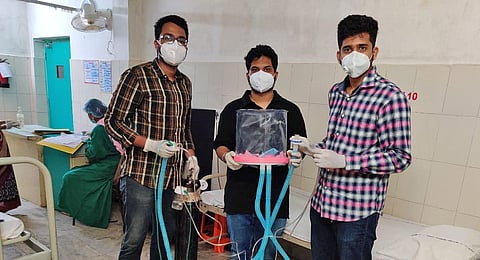IIIT-Bhubaneswar students make first-of-its-kind ventilation device to ease mild breathing issues
BHUBANESWAR: A group of seven engineering students from IIIT, Bhubaneswar claimed to have developed a first-of-its-kind helmet-like ventilation device that benefits patients suffering from mild respiratory distress. It can also act as a comfortable alternative to the suffocating PPE kits, the students claimed.Shaped as a bubble enclosure for the head, the device works on the principle of hyperbaric oxygen therapy - mostly used for treating diving-related illness and some other medical conditions.
Inside a hyperbaric chamber, a person is made to inhale almost pure oxygen to speed up body’s healing process. Some researchers believe the therapy can also be useful for treating respiratory diseases. Though the therapy is used in a wide variety of medical conditions, experts often express doubts regarding adequate scientific validation of its efficacy or safety. In this therapy, the patient is made to breathe oxygen in the pressurised chamber. The atmospheric pressure inside the chamber is raised up to three times higher than normal.
These students - Tapaswin Padhy, Sai Sambit Nayak, Sidharth Nayak, Ananya Aprameya, Jivitesh Debata, Vitthal Gupta, Nand Kishore Gupta, Divyajyoti Dash and Shovit Mitra - took four months to design the device named ‘Swasner.’
They used two plastic rings, bearing three ports, to make the device’s base. A round-shaped piece of mackintosh fabric is stitched to the rings so as to have a t-shirt like grip on the user’s neck. The base is fitted to the bubble-like enclosure or chamber inside which pure oxygen is pumped in. The bubble, which expands as the air fills in, is made of medical grade plastic that these students had procured from CIPET, Bhubaneswar. With the help of the ports at its base, the device can be connected to wall-mounted oxygen cylinders in hospitals.
“There are two different outlets for inhalation and exhalation. Through the inlet oxygen gets into the chamber, while the outlet - which is fitted to an anti-viral filter - lets the exhaled air to escape the chamber. There’s also a regulator attached to the device to control the air pressure and flow,” said Sidharth, a third year BTech student. These students have connected the device to an IoT-powered diagnostics monitoring system that allows doctors to check the patient’s vitals from remote locations.
The students claimed that the device could be an affordable alternative to costly ventilators. While it can be priced at `1,800 per piece, ventilators come for lakhs. “But the device may not be a viable option for critically-ill patients. However, it can enhance the treatment for Covid patients with mild respiratory issues,” added Tapaswin, another team member.
For turning it into a PPE kit, the device is connected to an air-pump instead of oxygen cylinder. The anti-viral filter acts as a guard. The students have conducted architectural tests for the device at a hospital in Cuttack. But human-intervention for clinical tests on patients is pending. They have already applied for patent.

